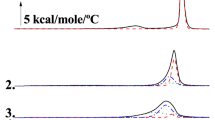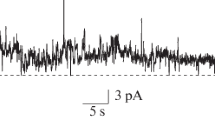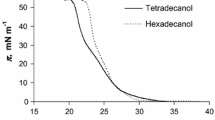Summary
The membrane permeability coefficients for the homologous monocarboxylic acids, formic through hexanoic, as well as benzoic and salicylic, were determined for egg phosphatidylcholine-decane planar bilayer membranes. The permeabilities of formic, acetic and propionic acid were also determined for “solvent-free” phosphatidylethanolamine bilayers. Permeability coefficients were calculated from tracer fluxes measured under otherwise symmetrical conditions, and precautions were taken to ensure that the values were not underestimated due to unstirred layer effects. The relation between the nonionic (HA) permeability (P m) and the hexadecane/water partition coefficient (K p ) was: logm=0.90 log Kp+0.87 (correlation coefficient=0.996). Formic acid was excluded from the analysis because its permeability was sixfold higher than predicted by the other acids. The permeabilities for “solvent-free” membranes were similar to those for decanecontaining membranes. The exceptionally high permeability of formic acid and the high correlation of the other permeabilities to the hexadecane/water partition coefficient is a pattern that conforms with other nonelectrolyte permeabilities through bilayers. Similarly, the mean incremental free energy change per methylene group (σΔG-CH2-) was −764 cal mol−1, similar to other homologous solutes in other membrane systems. However, much less negative σΔG values (−120, to −400 cal mol−1) were previously reported for fatty acids permeating bilayers and biological membranes. These values are due primarily to unstirred layer effects, metabolism and binding to membranes and other cell components.
Similar content being viewed by others
References
Alger, J.R., Prestegard, J.H. 1979. Nuclear magnetic resonance study of acetic acid permeation of large unilamellar vesicle membranes.Biophys. J. 28:1–14
Bean, R.C., Shepherd, W.C., Chan, H. 1968. Permeability of lipid bilayer membranes to organic solutes.J. Gen. Physiol. 52:495–508
Bidstrup, D.E., Geankoplis, C.J. 1963. Aqueous diffusivities of molecular carboxylic acids.J. Chem. Eng. Data 8:170–173
Bindslev, N., Wright, E.M. 1976. Effect of temperature on nonelectrolyte permeation across the toad urinary bladder.J. Membrane Biol. 29:265–288
DeGrella, R.F., Light, R.J. 1980a. Uptake and metabolism of fatty acids by dispersed adult rat myocytes. I. Kinetics of homologous fatty acids.J. Biol. Chem. 255:9731–9738
DeGrella, R.F., Light, R.J. 1980b. Uptake and metabolism of fatty acids by dispersed adult rat heart myocytes. II. Inhibition by albumin and fatty acid homologues, and the effect of temperature.J. Biol. Chem. 255:9739–9745
Diamond, J.M., Wright, E.M. 1969. Biological membranes: The physical basis of ion and nonelectrolyte selectivity.Annu. Rev. Physiol. 31:582–646
Dietschy, J.M. 1978. General principles governing movement of lipids across biological membranes.In: Disturbances in Lipid and Lipoprotein Metabolism. J.M. Dietschy, A.M. Gotto, Jr. and J.A. Ontko, editors. pp. 1–28. American Physiological Society, Bethesda, Md.
Finkelstein, A. 1976. Water and nonelectrolyte permeability of lipid bilayer membranes.J. Gen. Physiol. 68:127–135
Gallucci, E., Micelli, S., Lippe, C. 1971. Non-electrolyte permeability across thin lipid membranes.Arch. Int. Physiol. Biochim. 79:881–887
Green, J.W. 1949. The relative rate of penetration of the lower saturated monocarboxylic acids into mammalian erythrocytes.J. Cell. Comp. Physiol. 33:247–265
Gutknecht, J., Bisson, M.A., Tosteson, D.C. 1977. Diffusion of carbon dioxide through lipid bilayer membranes. Effects of carbonic anhydrase, bicarbonate and unstirred layers.J. Gen. Physiol. 69:779–794
Gutknecht, J., Bruner, L.J., Tosteson, D.C. 1972. The permeability of thin lipid membranes to bromide and bromine.J. Gen. Physiol. 59:486–502
Gutknecht, J., Tosteson, D.C. 1973. Diffusion of weak acids through lipid bilayer membranes: Effects of chemical reactions in the aqueous unstirred layers.Science 182:1258–1261
Haag, G., Bierbach, H., Holldorf, A.W. 1976. Some aspects of fatty acid absorption and metabolism by isolated epithelial cells from small intestine.In: Lipid Absorption: Biochemical and Chemical Aspects. K. Rommel and H. Goebell, editors. pp. 335–341. University Park Press, Baltimore, Md.
Hodgkin, A.L. 1951. The ionic basis of electrical activity in nerve and muscle.Biol. Rev. 26:339–365
Inui, K., Tabara, K., Hori, R., Kaneda, A., Muranishi, S., Sezaki, H. 1977. Black lipid membranes as a model for intestinal absorption of drugs.J. Pharm. Pharmacol. 29:22–26
Jackson, M.J., Williamson, A.M., Dombrowski, W.A., Garner, D.E. 1978. Intestinal transport of weak electrolytes. Determinatns of influx at the luminal surface.J. Gen. Physiol. 71:301–327
Katz, Y., Diamond, J.M. 1974. Thermodynamic constants for nonelectrolyte partition between dimyristoyl lecithin and water.J. Membrane Biol. 17:101–120
Klocke, R.A., Andersson, K.K., Rotman, H.H., Forster, R.E. 1972. Permeability of human erythrocytes to ammonia and weak acids.Am. J. Physiol. 222:1004–1013
Lamers, J.M.J. 1975. Some characteristics of monocarboxylic acid transfer across the cell membrane of epithelial cells from rat small intestine.Biochim. Biophys. Acta 413:265–276
Lamers, J.M.J., Hulsmann, W.D. 1975. Inhibition of pyruvate transport by fatty acids in isolated cells from rat small intestine.Biochim. Biophys. Acta 394:31–45
Miller, K.W., Hammond, L., Porter, E.G. 1977. The solubility of hydrocarbon gases in lipid bilayers.Chem. Phys. Lipids 20:229–241
Montal, M., Mueller, P. 1972. Formation of bimolecular membranes from lipid monolayers and a study of their electrical properties.Proc. Natl. Acad. Sci. USA 69:3561–3566
Mueller, P., Rudin, D.O. 1969. Translocators in biomolecular lipid membranes: Their role in dissipative and conservative bioenergy transductions.Curr. Top. Bioenerg. 3:157–249
Orbach, E., Finkelstein, A. 1980. The nonelectrolyte permeability of planar lipid bilayer membranes.J. Gen. Physiol. 75:427–436
Pauling, L. 1960. The Nature of the Chemical Bond, third edition. Cornell University Press, Ithaca, New York
Perrin, D.D., Dempsey, B. 1974. Buffers for pH and Metal Ion Control. John Wiley and Sons, New York
Rosen, H., Leaf, A., Schwartz, W.B. 1964. Diffusion of weak acids across the toad bladder. Influence of pH on non-ionic permeability coefficients.J. Gen. Physiol. 48:379–389
Roth, S., Seeman, P. 1972. The membrane concentrations of neutral and positive anesthetics (alcohols, chlorpromazine, morphine) fit the Meyer-Overton rule of anesthesia; negative narcotics do not.Biochim. Biophys. Acta 255:207–219
Sallee, V.L. 1979. Permeation of long-chain fatty acids and alcohols in rat intestine.Am. J. Physiol. 236:E721-E727
Sallee, V.L., Dietschy, J.M. 1973. Determinants of intestinal mucosal uptake of short- and medium-chain fatty acids and alcohols.J. Lipid Res. 14:475–484
Schwartz, S.E., Dietschy, J.M. 1980. Permeability characteristics of muscle membrane.Biochim. Biophys. Acta 600:961–973
Sherrill, B.C., Dietschy, J.M. 1975. Permeability characteristics of the adipocyte cell membrane and partitioning characteristics of the adipocyte triglyceride core.J. Membrane Biol. 23:367–383
Thompson, A.B.R. 1980. Effect of age on uptake of homologous series of saturated fatty acids into rabbit jejunum.Am. J. Physiol. 239:G363-G371
Thompson, A.B.R. 1982. Influence of sodium on major diffusion barriers to passive intestinal uptake.Am. J. Physiol. 243:G148-G154
Thompson, A.B.R. 1983. Experimental diabetes and intestinal barriers to absorption.Am. J. Physiol. 244:G151-G159
Thompson, A.B.R., Dietschy, J.M. 1981. Intestinal lipid absorption: Major extracellular and intracellular events.In: Physiology of the Gastrointestinal Tract. L.R. Johnson, editor. Vol. 2, pp. 1147–1220. Raven Press, New York
Walter, A., Hastings, D., Gutknecht, J. 1982. Weak acid permeability through lipid bilayer membranes: Role of chemical reactions in the unstirred layer.J. Gen. Physiol. 79:917–933
Westergaard, H., Dietschy, J.M. 1974. Delineation of the dimensions and permeability characteristics of the two major diffusion barriers to passive mucosal uptake in the rabbit intestine.J. Clin. Invest. 54:718–732
Wolosin, J.M., Ginsburg, H. 1975. The permeation of organic acids through lecithin bilayers: Resemblance to diffusion in polymers.Biochim. Biophys. Acta 389:20–33
Wright, E.M., Bindslev, N. 1976. Thermodynamic analysis of nonelectrolyte permeation across the toad urinary bladder.J. Membrane Biol. 29:289–312
Author information
Authors and Affiliations
Rights and permissions
About this article
Cite this article
Walter, A., Gutknecht, J. Monocarboxylic acid permeation through lipid bilayer membranes. J. Membrain Biol. 77, 255–264 (1984). https://doi.org/10.1007/BF01870573
Received:
Revised:
Issue Date:
DOI: https://doi.org/10.1007/BF01870573




